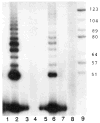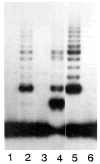Telomerase activity in skeletal sarcomas
- PMID: 9831112
- PMCID: PMC5295501
- DOI: 10.1007/BF02303833
Telomerase activity in skeletal sarcomas
Abstract
Background: Telomerase is a ribonucleoprotein that adds TTAGGG nucleotide repeats onto the ends of eukaryotic chromosomes to maintain telomere integrity. Somatic cells do not express telomerase and stop dividing when the chromosomal ends are shortened critically after many cell divisions. Immortal cell lines and cancer cells apparently have telomerase activity that contributes to an unlimited number of cell cycles. The purpose of our study is to investigate whether telomerase activity is expressed in primary malignant tumors of the skeletal system when compared to adjacent normal tissue.
Methods: Fresh tumor and normal tissue was collected from 14 patients (10 males, 4 females; age range, 8 to 76 years) and protein extraction performed. The tumors included seven osteosarcomas (three examined before and after chemotherapy), two chondrosarcomas, two spindle cell tumors, one hemangiopericytoma, one chordoma, and one adamantinoma. Telomerase activity was analyzed by using a highly sensitive polymerase chain reaction (PCR)-based assay (telomere repeat amplification protocol [TRAP]).
Results: Telomerase activity was found in 8 of 14 sarcoma patients (57%) using the TRAP assay. Compared to HeLa cell extract (positive control), telomerase activity in the tumor specimen ranged from 0 (in osteosarcoma) to 11.7% (in hemangiopericytoma). There was variation in the number of telomeric repeats generated by telomerase. At least five telomeric bands (e.g. 50, 56, 62, 68, 74 bp) in a ladder pattern had to be present before telomerase activity was considered positive in our analysis.
Conclusions: Telomerase activity may be an oncogenic sustaining event helping to maintain the transformed phenotype seen in malignant tumors of the bone. The degree of telomerase activity varies among skeletal malignancies, but was less than that observed in HeLa cells. The majority of osteosarcomas showed no telomerase activity.
Figures


References
-
- Silverberg E, Lubera J. Cancer statistics 1987. CA. 1987;37:2–20. - PubMed
-
- Dahlin DC, Unni KK. Introduction and scope of study. In: Dahlin DC, Unni KK, editors. Bone Tumors. Springfield, IL: Charles C Thomas; 1986. pp. 3–10.
-
- Campanacci M, Bacci G, Bertoni F, Picci P, Minutillo A, Francschi C. The treatment of osteosarcoma of the extremities: twenty years experience at the Instituto Ortopedico Rizzoli. Cancer. 1981;48:1569–81. - PubMed
-
- Eilber FR, Morton DL, Eckardt J. Limb salvage for skeletal and soft tissue sarcomas: multidisciplinary preoperative therapy. Cancer. 1984;53:2579–84. - PubMed
-
- Davis AM, Bell RS, Goodwin PJ. Prognostic factors in osteosarcoma: a critical review. J Clin Oncol. 1994;12:423–31. - PubMed
Publication types
MeSH terms
Substances
Grants and funding
LinkOut - more resources
Full Text Sources
Other Literature Sources
Medical
